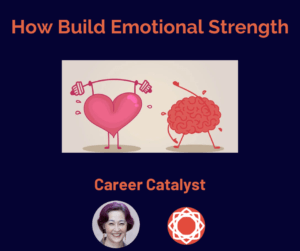
I don’t know about you, but I try to spend a couple days each week doing strength training as part of my fitness routine. Working with weights helps strengthen bones, maintains a greater range of motion, and helps protect against heart disease and injury.
So how can we do the same thing for our minds? Emotional strength is as important as physical, and while the two overlap a little (mental health professionals tell us to exercise!), they also need different attention from us.
Much like working your body out, you will need to repeat the steps to building emotional strength and resilience regularly, but the steps are actually pretty straightforward.
Step 1: Act.
Find a small step you can take to improve your current situation. For example, if you hate your job and it’s sucking up all your energy, take a small action like spending 15 minutes looking for something else. You don’t have to choose the next thing, but focusing on the doing of a task will remind you that you have more power than you feel in the moment. Those small actions will lead to other small actions if you’re intentional. Once you feel a bit more empowered by having taken some of these steps, sketch a list of all the steps you think you need to take, remembering to break each big item (overhauling your resume, for instance) into a series of smaller steps (updating your current job accomplishments).
Step 2: Own your strengths.
Things may seem hard for you right now, but remember that you’ve survived hard things before. Reflect on those earlier situations and what it took for you to overcome them. Focus on your own actions and accomplishments instead of what others did for you. For instance, if you were able to leave a job in which your boss yelled at you because a family friend needed help starting a business, focus on what you offered the family friend so you remember it wasn’t an act of charity but a mutually beneficial arrangement.
I find it helpful to make a running list of accomplishments, as well. You can do this however you want—a Google Doc, a physical notebook, memos on your phone. But make sure it’s something you can access easily because you will want to keep adding to it. And on bad days, you may want to skim it to remind yourself of your successes. (If you struggle to get started, it’s okay to list very small things like eating your veggies yesterday. The small things will remind you of other small things, which will eventually remind you of bigger things.)
Step 3: Connect.
Building and maintaining relationships with others is a need that’s hard-wired in humans. Whether you prefer a small core group of friends or love meeting and befriending new people, you need others in your life who care about you and support you. If you’ve been in an unhappy place for a while, you may have lost touch with people who were important to you in the past. If the relationship simply faded, don’t be afraid to reconnect. People you care about probably also care a lot about you, so reviving those relationships is often easy and very powerful. With some old friends, you’ll find you reconnect instantly and it feels like no time has passed, and with others, you get to embark on a journey of rediscovering each other.
If, however, things ended with a disagreement, identify your own part of that and apologize for it. Not everyone will be receptive to an apology but you can feel good about having tried.
Additionally, you can look for new connections by finding places or groups that are important to you. This is especially important if you’re living somewhere you don’t already have friends. Find things that are meaningful to you—French lessons, a church, temple, or synagogue; hiking meetups, coffee shops with shared tables, volunteering options. You already have at least some mutual interests when you find these social groups, so building meaningful connections will be easier.
As the Girl Scouts sing,
Make new friends but keep the old.
One is silver and the other, gold.
Step 4: Repeat as necessary.



